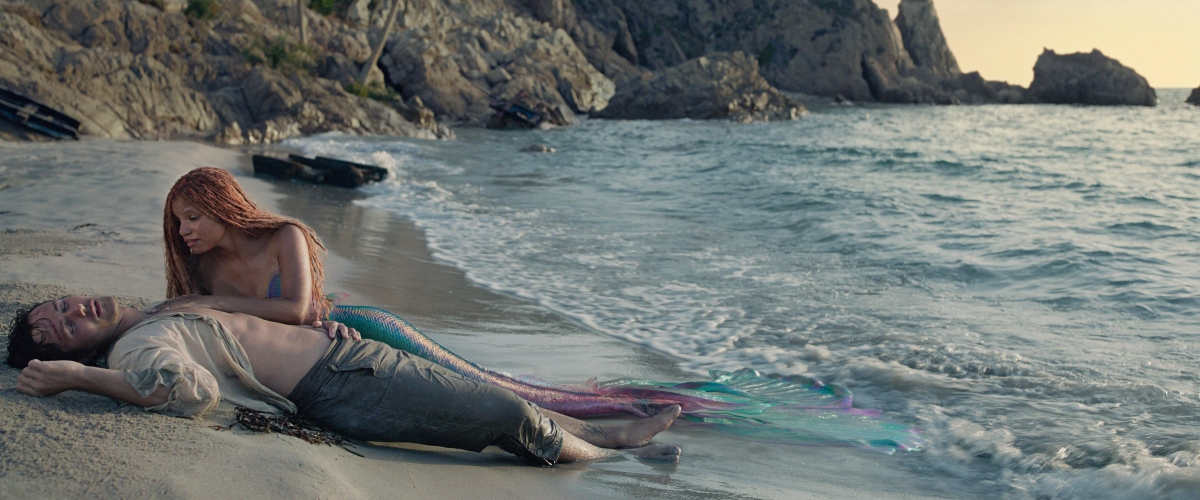
Part of Our World: On the Mermaids of Walt Disney, Hans Christian Andersen, and W.B. Yeats
Gabrielle Bellot: “The mermaid is the Other; she is also us.”
Near the climax of Walt Disney’s The Little Mermaid (2023), a new live-action remake of the 1989 animated film, I found myself struck by a brief scene not in the original. In both versions of the movie, Ariel, the titular mermaid, has fallen in love with Eric, a human prince, and, through a magical deal with a sea-witch, has had her green-blue tail transformed into human legs for three days, by the end of which she must have kissed her prince or she will be forcefully turned back into a mermaid.
Against all odds—the witch Ursula taking her voice as payment for the transfiguration spell, her existential culture shock at the (quite literal) gravity of walking on land amongst humans, the witch transforming at the last minute into a beautiful human girl who attempts to woo Ariel’s prince—Ariel nearly fulfills the terms of the magic, but just before their lips touch, time runs out, and her legs fuse back into a resplendent fishtail to the astonishment of her human onlookers.
In the original, Ursula cackles, transforms herself into her normal octomaid form—a pale lavender-tinted human upper half, eight black tentacles on the bottom—grabs Ariel and leaps off the deck of the ship into the sea, after which Eric attempts to flee after them in a rowboat. But in the new film, his near-kiss with Ariel takes place on land, and he flees to the shore after her, stopped from getting a boat by a character not in the original—his mother, a Black woman who is the island’s queen. She puts her hand on Eric’s back as she attempts to calm him down, his own Caucasian face ruddy from exertion, and delivers a striking line.
“It’s just that our worlds were never meant to be together,” she says slowly. For much of the movie, she, along with other humans, has cautioned Eric against getting involved with merfolk, even blaming shipwrecks on the “sea gods.” Just before the line about our separate worlds, upon seeing Ariel and Ursula transform, she had cried out to Eric that “This is the work of the sea gods. I’ve warned you. Their whole world is evil.”
On the beach, Eric turns to stare pensively at her, and then the scene switches to Ursula and Ariel—the latter of whom is also portrayed by a Black woman in this new version—underwater. But there is something memorable about Eric and his mother’s interaction. On the one hand, the queen is explicitly talking about the distinct worlds of mergirl and land boy, any mixing of which, she believes, is likely to be tragic at best and lethal at worst.
On the other hand, she could just as easily be talking about race, specifically the specter of the fear of miscegenation that has haunted American history for so long, and which was on full display when the fact that Ariel would be played by a Black actress (Halle Bailey) was revealed and a prodigious, if predictable, onslaught of racial grievance followed, with many commenters furiously castigating the casting choice as “woke,” often with racist rhetoric.
This reaction was especially pathetic given the fact that as fantasy beings, mermaids can be designed any way we like, and the additional fact that if mermaids had truly evolved into existence, they would almost certainly not have humanlike skin at all, but would probably look more like pinnipeds or porpoises, the two classes of sea creature most often cited as the historical sources of “real” mermaid sightings.
To be sure, the eponymous little mermaid is overtly light-skinned in the 1836 fairytale of the same name by Hans Christian Andersen that Disney’s film is loosely based on, but both Disney versions take many liberties with the story—and adaptations are ultimately new stories, allowed to be told in whatever way the creators wish. To rail against the dark skin of a mermaid in a loose adaptation of a fairytale is the height of narrow-mindedness.
Ironically, the new movie, which is largely a faithful retelling of the animated version, is not explicitly about race at all. Its cast is multiethnic, but nothing is ever made of this; Ariel’s mermaid sisters are all of different races (which raises its own logistical questions, but these are beyond the scope of the movie). Moreover, the island that the land-based scenes take place on is a kind of Disneyfied version of the colonial-era Caribbean, where people of all ethnicities seem to happily live together, a colonial age in which colonialism, miraculously, seems not to exist. The fact that Ariel is Black and Eric is white never explicitly comes up. As a story about a mermaid in love with a land-based man, this makes sense; racial differences and anguish are human myths themselves, less relevant than the ontological divide between land and sea for our cinematic lovers.
Racial differences and anguish are human myths themselves, less relevant than the ontological divide between land and sea.
Still, I find myself thinking about that line from Eric’s mother. She herself still hasn’t accepted the possibility that a man and a mergirl can live happily ever after together, that people from such foundationally different worlds can truly fall in love. (They do, of course, since it’s a Disney film.) To her, this is commonsensical, a well-intended word of caution to her grieving son. But it also represents her own small-mindedness—at least temporarily—about what is possible.
It’s unlikely that the director meant the line as a subtle nod to racial tensions, given the film’s commitment to not bringing it up, but because of how feverishly race haunts the American landscape, and how much alarm people still raise about something as anodyne as the complexion of a mermaid, it’s difficult not to read the line this way.
Separated, like a mermaid’s body, but supposedly equal—even if we can never truly be equal if we separate ourselves from whatever, or whomever, we imagine as the Other.
*
Separation, as an idea, is inextricable from mermaids. Like the centaur, the mermaid is ripe for such symbolism; part human, part fish, they literally embody multiple realities, realities that do not neatly fit together. At least visually, a mermaid does not overtly seem to fit either in water or on land—and so there is perhaps an inherent existential uncertainty at the heart of their stories, beautiful for those few who can accept that people, like mermaids, contain multitudes, and fatally tragic for those figures we so often find in mermaid stories who wish to be only one or the other, yet know they can never be perfectly happy in either world.
Though mermaids are dual beings, we tend to treat them primarily as if they are human—in part because we tend to portray them as beings we can relate to due to their upper halves being human, not the other way around. Would The Little Mermaid exist if Ariel’s upper half was a fish’s, as in Rene Magritte’s famous painting The Collective Invention (1934)? It’s easy to interpret Magritte’s painting as an absurdity and Ariel as natural, yet there is little reason for this other than our evolutionary preference for humanlike faces. Magritte’s inversion captures the surrealistic strangeness of merfolk myths we tend to ignore by virtue of their conventional, humanlike beauty.
All of this raises a simple question: how do we depict mermaids? Do we imagine a fantastical realm in which their oddity does not matter, or do we try to make them fit, despite their corporeal strangeness, into a realistic world, as in magical realism?
The new Little Mermaid seems unsure of its answer, attempting to portray a photorealistic undersea domain while also embracing fantasy, and the result feels rough. In the animated version of The Little Mermaid, Ariel, King Triton, and her sisters move through the sea fluidly, and because the denizens of the deep are also hand-drawn, they are easily anthropomorphized in classic cartoon fashion. Reducing the realism of sea creatures makes mermaids fit in more seamlessly; the natural world itself doesn’t need to be, well, “natural.”
The live-action adaptation, however, lacks this visual consistency. To be sure, most of the sea creatures look like their real-life counterparts; Flounder, Ariel’s piscine best friend, seems very much the part of a fish; Ursula’s eel minions are visual delights (though electric eels don’t live in saltwater); and Scuttle the seabird looks great. But Sebastian the crab appears grotesque, his body moving with the semblance of a real crustacean, while his face is obviously, almost jarringly computer-generated, representing the filmmakers’ incomplete commitment to realism or fantasy. As a character, Sebastian is a show-stealer, his hilarious commentary in Daveed Diggs’s meandering Caribbean accent—especially alongside Awkwafina’s playful take on Scuttle—consistently drawing laughs, but every time his face appears, there is something odd about it, realism and cartoonishness Frankensteined into one being.
Then there are the mermaids. There’s something inherently awkward not just about live-action adaptations of animation, but about trying to authentically capture how mythic beings might move. And mermaids are an especially tough case. At once human and marine, mermaids’ bodies need to accommodate multiple ranges of motion, a mobility that looks natural for ocean creatures while retaining a recognizable humanity (and, with that, their seductiveness). Mermaids should seem as propulsive as dolphins, as playfully acrobatic as sea lions.
In the new film, though, most of the minor mermaids move stiffly, their bodies posed in an awkward uprightness as if to make them seem like standing humans, their arms flapping unnecessarily at their sides as they swim like inexperienced scuba divers who use their arms rather than their fins, the whole thing resulting in a kind of uncanny valley of the unreal. Ariel, fortunately, feels the most natural of the merfolk, moving with elegant swiftness and dynamism underwater, even if she also has moments of kinetic curiousness. Ursula’s tentacles, meanwhile, move with a life of their own, a clever, relatively convincing nod to the appearance of real-life octopus arms.
Hans Christian Andersen’s original fairytale is also a story about separateness—land from sea, familiar from unfamiliar, human from nonhuman.
The movie is more than its visuals, of course, and given the difficulty of figuring out how a mythic being like a mermaid might move, the film tries its best, its awkwardness never a reason to stop watching. If anything, its inability to commit to realism or fantasy reflects merfolk’s inherent dividedness, their definitional ambiguity—though this makes for an odd, uneven viewing experience, and it’s hardly what the filmmakers intended. Like Eric’s mother, the creators have not yet figured out how our two worlds can be united.
*
Hans Christian Andersen’s original fairytale is also a story about separateness—land from sea, familiar from unfamiliar, human from nonhuman. As in Disney’s versions, Andersen’s mermaid falls in love with a human prince who she saves from drowning one night when his ship is destroyed in a storm; she brings him to land, but he fails to realize who his savior is. Tortured by her inability to be with her prince, she becomes depressed, and she is finally pushed into making a deal with a “sea witch” to transform her tail into human legs.
Of course, this comes at a price: every step she takes will feel like knives underfoot, and she will lose her voice, unable to charm the prince through her siren song. If, despite all this, she manages to marry the prince before he can wed anyone else, she will retain her humanity. If she fails, she will die, becoming seafoam, as all mermaids do in the fairytale.
Even with the excruciating pain and inability to speak, she tries her best to woo the prince, but he still marries someone else. Her mer-sisters make a new deal with the witch—in exchange for their hair—that she can return to being a mermaid if she kills the prince with an enchanted dagger, but she refuses to, dying in the dawn light instead.
But instead of dissolving forever into foam, she realizes, to her shock, that she has been transformed into a sylph, or an air spirit, for her self-sacrifice, which gives her a new opportunity: to rise up to heaven for her good deeds on Earth. The alternately murderous and religious overtones of this ending, of course, do not appear in the movies, but it made sense that Andersen might imagine such a painful, peculiar conclusion.
I imagined myself, for a moment, diving through the sea, a fishtail aflutter. There’s something in that.
This is because Andersen, as I’ve written, may have composed “The Little Mermaid” as a metaphor for his own seemingly unobtainable love for a man who did not, by his own admission, feel the same; it is easy to read the fairytale as a symbol of that enduring genre of lovers cursed to come from disparate realities. Like his mermaid, Andersen was not chosen. As a religious man, he may have found solace in such lofty thoughts as an ascent toward heaven, though the mermaid—now a “daughter of the air”—still has centuries of good deeds to accomplish before she can make it there, reflecting Andersen’s own lifelong labor to find happiness amidst his frequent loneliness.
Echoing these sad themes, the new movie begins with a quote from Andersen’s story: “But a mermaid has no tears, and therefore they suffer more.” It’s a curious choice—apt for Andersen’s tragic fairytale and unrequited real-life love, but less so for the happy endings that Disney films typically promise. You might think the quote signals a film significantly more faithful to Andersen’s plot, but you’d be wrong. Instead, it’s emblematic of a persistent problem in the film: its half-hearted gestures, which end up being half-hearted partly because the movie is trying to do too much.
There are many such moments. A brief scene midway through the movie, for instance, features King Triton and his daughters—except Ariel—cleaning shipwreck debris from the reef. The Sea King notes that humans “are the most dangerous species” due to the damage they do, and he reflects on how long it will take for the coral to grow back. This is obviously intended as a nod toward environmentalism, and the message is both true and well-intentioned, but this environmentalist ethos never appears elsewhere in the film, so the scene feels tacked on more to check a box than to commit to an argument.
Then there’s the music. The film seems uncertain about how musically faithful it wishes to be, so it includes both older numbers and a few new songs. Bailey performs a beautiful rendition of “Part of Your World,” and anytime she sings brings aural delight. “Under the Sea,” one of the most memorable of the original compositions, also sounds good here, and, to the filmmakers’ credit, the scene features a colorful cast of sea life, but the song’s choreography is stiff, and there are also baffling moments, like Ariel stroking jellyfish tentacles (are mermaids immune to their sting?).
The new stuff is where the half-heartedness comes in most: Prince Eric delivers a fine, if generic-sounding, new song, nothing too memorable, while Scuttle and Sebastian perform an inexplicable hip-hop-inspired number by Lin Manuel Miranda—inexplicable because it comes out of nowhere and does not fit the tone of the rest of the music, making it, like the environmentalist message, feel extraneous.
Like Eric’s mother, the creators have not yet figured out how our two worlds can be united.
Even the overall logic of the film occasionally seems half-hearted. Conventional logic is not meant to guide such stories, but there are moments when fairytale and realism collide in weird ways. When Ariel is transfigured by Ursula into a human, for instance, she is hundreds, if not thousands, of feet underwater, oceanic pressures that would crush a human, yet she easily swims with her new legs to the surface.
Later, Eric casually dives down to a similar depth to attack Ursula. I’m happy to suspend my disbelief in general, and I’m not one who believes that rules in any world, ours included, are necessarily fixed; for me, mundane life and a sense of magic can and should coexist. Even with such allowances, there’s still something jarring about these cinematic moments, as if the film is unsure which logic it wishes to follow.
I don’t say all this solely to criticize the movie. I may not believe that Disney needs to make live-action remakes, and they’re usually not as good as the originals, but this one exceeded my (admittedly low) expectations. The movie makes a few interesting improvements, like giving Prince Eric slightly more of a story by delving into his family and motivations—he sails to establish trade with other nations—and by making Ursula slightly less of a simplistic villain, her deal with Ariel now a vengeful attempt to reclaim political power she has lost by being sidelined by her brother, Triton. Bailey is undoubtedly a wonderful Ariel.
And the movie also performed that simplest of spells: it made me smile. How not to smile during the winking silliness of “Kiss the Girl,” or when Ariel finally regains her voice and the simple but haunting melody of “Part of My World” echoes in the air, or at the unabashed himbo-ness of a near-shirtless Disney prince? How not to smile when you see a grinning kid in the theater the same age you were when you first saw the original, knowing that even if they haven’t seen the animation, they’re still encountering a bit of myth-magic of their own, now with a cast more likely to look like them?
When the movie was over, and I slipped into the bathroom, I heard another girl singing “Part of My World,” and it made me smile again in my stall, realizing that the movie, for all of its awkwardness and unevenness, had reminded some of us of what had made us want to see the film in the first place. I imagined myself, for a moment, diving through the sea, a fishtail aflutter. There’s something in that.
*
Curiously, the movie left me thinking less about Andersen’s fairytale—which I’ve long enjoyed—than about other literary images of mermaids. Certainly, there are many to explore, even if “The Little Mermaid” tends to dominate such literary discussions: T.S. Eliot’s allusions to sea-girls in “Prufrock”; poems about mermen and mermaids by Tennyson; Monique Roffey’s recent novel about a Taino mermaid, The Mermaid of Black Conch, which puts a beautiful Caribbean myth on center stage, rather than the European depictions, like Andersen’s, that are the most culturally commonplace. But it was a different piece, a short poem by W. B. Yeats called “The Mermaid,” that I’ve been thinking about instead.
“A mermaid found a swimming lad,” it begins, “picked him for her own, / pressed her body to his body, / laughed; and plunging down / forgot in cruel happiness / that even lovers drown.” The poem is the third part of a miniature cycle of poems, “A Man Young and Old,” and it first appeared in 1927 in October Blast. Its romantic, myth-inflected imagery is typical of Yeats. Despite its brevity and superficial simplicity, I quickly found myself quietly bewitched by “The Mermaid,” thinking about how it relates to Andersen and Disney, and how it relates to that sense of separate worlds the queen evokes.
The risk of drowning exists, as Yeats wrote, but so does the transcendent beauty of getting to know a world utterly unlike your own.
In just six lines, Yeats manages to capture the existential tragedy of so many myths about the merfolk: that we may fall in love with them, and they with us, but that that love is often doomed, our worlds of land and sea perhaps too different for love to overcome. That death for one of us—in this case, the swimming boy—is almost the certain outcome if we do try to live in both worlds, unless we change or compromise in some way. Ariel saves her boy rather than drowning him—but would it have been so surprising if she had accidentally done just this, overjoyed by the sight of him in the water, the boy finally part of her world?
Of course, this is a somewhat charitable interpretation of the poem. After all, it’s never clear that the human loves her back or has consented to anything at all, and it’s possible to read the piece as a parable of the fatal consequences of one-sided, selfish desire. The mermaid may indeed love the lad, but without asking him what he wants, she grabs him and kills him—without meaning to—as she tries to bring him to her deeper, bluer world. Her happiness is not innocent, after all, but “cruel.”
In the darkest myths about sea-girls, mermaids can be deadly beings, their seductive sirenic song luring sailors to shipwreck, if they do not simply grab and drown humans to begin with. Yeats’s mermaid seems more enchanted than evil, despite the nod to her cruelty, but either way it is still a lethal love, an affair as tragically brief as the verses.
I appreciate the poem’s nod to their bodies being pressed together; in all versions, The Little Mermaid is a relatively chaste tale, where mermaid and human rarely touch until she has been transformed into one of us. Here, though, there is something special in this moment of human pressed against myth and mystery, human pressed to nature. We are so often taught to imagine ourselves, as humans, separate from nature, as if we have been cleaved from it—yet we are also intimately connected to the natural world, as natural as any other being, and mermaids’ bodies symbolize this well. The mermaid is the Other; she is also us.
When we encounter mermaids, then, like Yeats’s swimmer, we are meeting both something we understand and the wilder, weirder aspects of ourselves we’re often taught to repress. It is a risk, always—but one that can teach us about acceptance and the multitudes we all contain. Expand this to humans meeting other, unfamiliar humans, and we have a poem about the value of listening to each other rather than “cruelly” or selfishly assuming what we each want. Tribalism and division don’t lead to happiness; listening to each other, no matter how different we seem, at least offers a chance of joy.
Eric’s mother realizes this by the end of the film, when she accepts Ariel and Eric’s love—a more palatable love, perhaps, because she has two legs again, but still a love connected to a being with more experience undersea than on land. She comes to accept the Other as one of her own. The risk of drowning exists, as Yeats wrote, but so does the transcendent beauty of getting to know a world utterly unlike your own. The new Little Mermaid is no great film, but I hope it can at least teach this lesson so central to stories about humans and merfolk, about us and them, with the rare bonus—outside of Disney—that the two lovers get to survive.
Gabrielle Bellot
Gabrielle Bellot is a staff writer for Literary Hub. Her work has appeared in The New York Times, The Atlantic, The New York Review of Books, The New Yorker, The Paris Review Daily, The Cut, Tin House, The Guardian, Guernica, The Normal School, The Poetry Foundation, Lambda Literary, and many other places. She is working on her first collection of essays and a novel.












